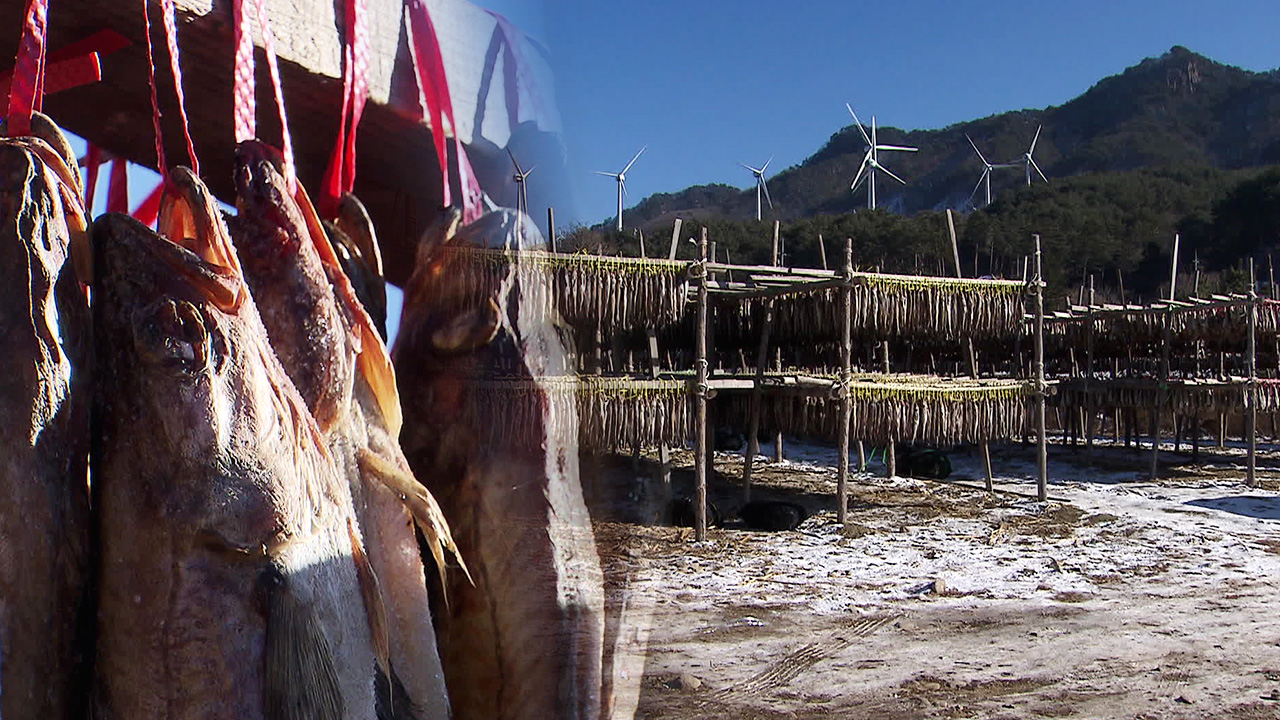Cold weather marks start of pollack drying season
입력 2024.12.29 (00:03)
읽어주기 기능은 크롬기반의
브라우저에서만 사용하실 수 있습니다.
[Anchor]
As the severe cold sets in, some places are getting busier.
One of those places is the pollack drying fields.
In Inje, Gangwon Province, at the largest pollack production area in the country, full-scale drying process of pollack has begun.
Reporter Lee Hyun-ki visited the location.
[Report]
At the foot of Seoraksan, where white snow has settled thickly.
Bundles of pollack are hung on drying frames made of wood.
Pollack, as thick as an adult's forearm, sway back and forth in the mountain wind that rushes through the valley.
As the temperature drops below minus 10 degrees Celsius, the drying process of pollack has commenced in full swing.
Foreign workers momentarily forget the biting winter cold as they watch the drying frames get filled one by one.
[Uyi/Vietnamese Worker: "(How is it when you come here?) The gloves are warm, the clothes are warm. The pants are warm, I have many clothes. It's okay."]
In the cold below minus 10 degrees, the pollack alternates between freezing and thawing, which makes the fish meat fluffy.
This is what the drying frames look like, set up two stories high.
As you can see, bundles of pollack are hung densely.
If it freezes and thaws for three to four months in the cold, it will be reborn as golden dried pollack.
After about 100 days of drying, it will be transformed into delicious dried pollack and shipped to the market in the spring of next year.
[Lee Kang-yeol/President of Inje Export Association: "It's really the worst condition for people to live in, right? But that temperature is optimal for drying pollack."]
There are about 20 pollack drying fields located in Yongdae-ri, Inje-gun, the largest area of dried pollack production in the country.
They produce 8 million dried pollack, which accounts for 70% of domestic production.
However, this year, the export of dried pollack processed from Russian pollack to the U.S. has taken a hit due to U.S. import regulations on Russian products.
In response, the dried pollack industry is working hard to devise plans to diversify exports to Southeast Asia, including Vietnam, and Australia.
This is KBS News, Lee Hyun-ki.
As the severe cold sets in, some places are getting busier.
One of those places is the pollack drying fields.
In Inje, Gangwon Province, at the largest pollack production area in the country, full-scale drying process of pollack has begun.
Reporter Lee Hyun-ki visited the location.
[Report]
At the foot of Seoraksan, where white snow has settled thickly.
Bundles of pollack are hung on drying frames made of wood.
Pollack, as thick as an adult's forearm, sway back and forth in the mountain wind that rushes through the valley.
As the temperature drops below minus 10 degrees Celsius, the drying process of pollack has commenced in full swing.
Foreign workers momentarily forget the biting winter cold as they watch the drying frames get filled one by one.
[Uyi/Vietnamese Worker: "(How is it when you come here?) The gloves are warm, the clothes are warm. The pants are warm, I have many clothes. It's okay."]
In the cold below minus 10 degrees, the pollack alternates between freezing and thawing, which makes the fish meat fluffy.
This is what the drying frames look like, set up two stories high.
As you can see, bundles of pollack are hung densely.
If it freezes and thaws for three to four months in the cold, it will be reborn as golden dried pollack.
After about 100 days of drying, it will be transformed into delicious dried pollack and shipped to the market in the spring of next year.
[Lee Kang-yeol/President of Inje Export Association: "It's really the worst condition for people to live in, right? But that temperature is optimal for drying pollack."]
There are about 20 pollack drying fields located in Yongdae-ri, Inje-gun, the largest area of dried pollack production in the country.
They produce 8 million dried pollack, which accounts for 70% of domestic production.
However, this year, the export of dried pollack processed from Russian pollack to the U.S. has taken a hit due to U.S. import regulations on Russian products.
In response, the dried pollack industry is working hard to devise plans to diversify exports to Southeast Asia, including Vietnam, and Australia.
This is KBS News, Lee Hyun-ki.
■ 제보하기
▷ 카카오톡 : 'KBS제보' 검색, 채널 추가
▷ 전화 : 02-781-1234, 4444
▷ 이메일 : kbs1234@kbs.co.kr
▷ 유튜브, 네이버, 카카오에서도 KBS뉴스를 구독해주세요!
- Cold weather marks start of pollack drying season
-
- 입력 2024-12-29 00:03:36

[Anchor]
As the severe cold sets in, some places are getting busier.
One of those places is the pollack drying fields.
In Inje, Gangwon Province, at the largest pollack production area in the country, full-scale drying process of pollack has begun.
Reporter Lee Hyun-ki visited the location.
[Report]
At the foot of Seoraksan, where white snow has settled thickly.
Bundles of pollack are hung on drying frames made of wood.
Pollack, as thick as an adult's forearm, sway back and forth in the mountain wind that rushes through the valley.
As the temperature drops below minus 10 degrees Celsius, the drying process of pollack has commenced in full swing.
Foreign workers momentarily forget the biting winter cold as they watch the drying frames get filled one by one.
[Uyi/Vietnamese Worker: "(How is it when you come here?) The gloves are warm, the clothes are warm. The pants are warm, I have many clothes. It's okay."]
In the cold below minus 10 degrees, the pollack alternates between freezing and thawing, which makes the fish meat fluffy.
This is what the drying frames look like, set up two stories high.
As you can see, bundles of pollack are hung densely.
If it freezes and thaws for three to four months in the cold, it will be reborn as golden dried pollack.
After about 100 days of drying, it will be transformed into delicious dried pollack and shipped to the market in the spring of next year.
[Lee Kang-yeol/President of Inje Export Association: "It's really the worst condition for people to live in, right? But that temperature is optimal for drying pollack."]
There are about 20 pollack drying fields located in Yongdae-ri, Inje-gun, the largest area of dried pollack production in the country.
They produce 8 million dried pollack, which accounts for 70% of domestic production.
However, this year, the export of dried pollack processed from Russian pollack to the U.S. has taken a hit due to U.S. import regulations on Russian products.
In response, the dried pollack industry is working hard to devise plans to diversify exports to Southeast Asia, including Vietnam, and Australia.
This is KBS News, Lee Hyun-ki.
As the severe cold sets in, some places are getting busier.
One of those places is the pollack drying fields.
In Inje, Gangwon Province, at the largest pollack production area in the country, full-scale drying process of pollack has begun.
Reporter Lee Hyun-ki visited the location.
[Report]
At the foot of Seoraksan, where white snow has settled thickly.
Bundles of pollack are hung on drying frames made of wood.
Pollack, as thick as an adult's forearm, sway back and forth in the mountain wind that rushes through the valley.
As the temperature drops below minus 10 degrees Celsius, the drying process of pollack has commenced in full swing.
Foreign workers momentarily forget the biting winter cold as they watch the drying frames get filled one by one.
[Uyi/Vietnamese Worker: "(How is it when you come here?) The gloves are warm, the clothes are warm. The pants are warm, I have many clothes. It's okay."]
In the cold below minus 10 degrees, the pollack alternates between freezing and thawing, which makes the fish meat fluffy.
This is what the drying frames look like, set up two stories high.
As you can see, bundles of pollack are hung densely.
If it freezes and thaws for three to four months in the cold, it will be reborn as golden dried pollack.
After about 100 days of drying, it will be transformed into delicious dried pollack and shipped to the market in the spring of next year.
[Lee Kang-yeol/President of Inje Export Association: "It's really the worst condition for people to live in, right? But that temperature is optimal for drying pollack."]
There are about 20 pollack drying fields located in Yongdae-ri, Inje-gun, the largest area of dried pollack production in the country.
They produce 8 million dried pollack, which accounts for 70% of domestic production.
However, this year, the export of dried pollack processed from Russian pollack to the U.S. has taken a hit due to U.S. import regulations on Russian products.
In response, the dried pollack industry is working hard to devise plans to diversify exports to Southeast Asia, including Vietnam, and Australia.
This is KBS News, Lee Hyun-ki.
-
-

이현기 기자 goldman@kbs.co.kr
이현기 기자의 기사 모음
-
이 기사가 좋으셨다면
-
좋아요
0
-
응원해요
0
-
후속 원해요
0















이 기사에 대한 의견을 남겨주세요.